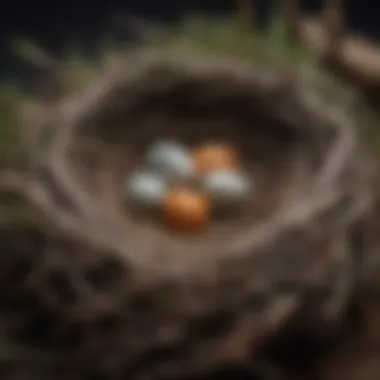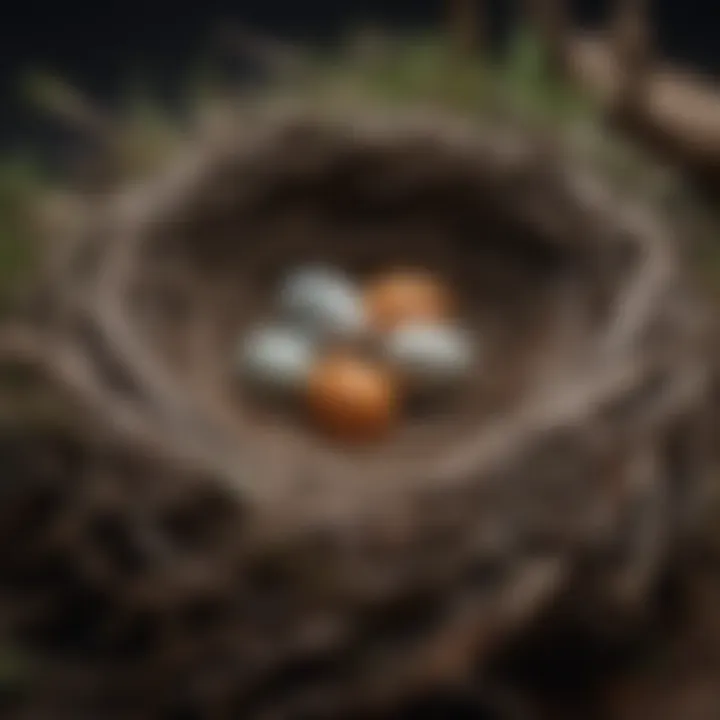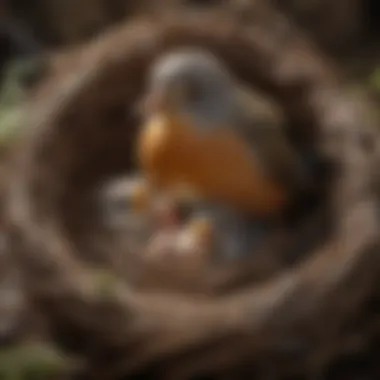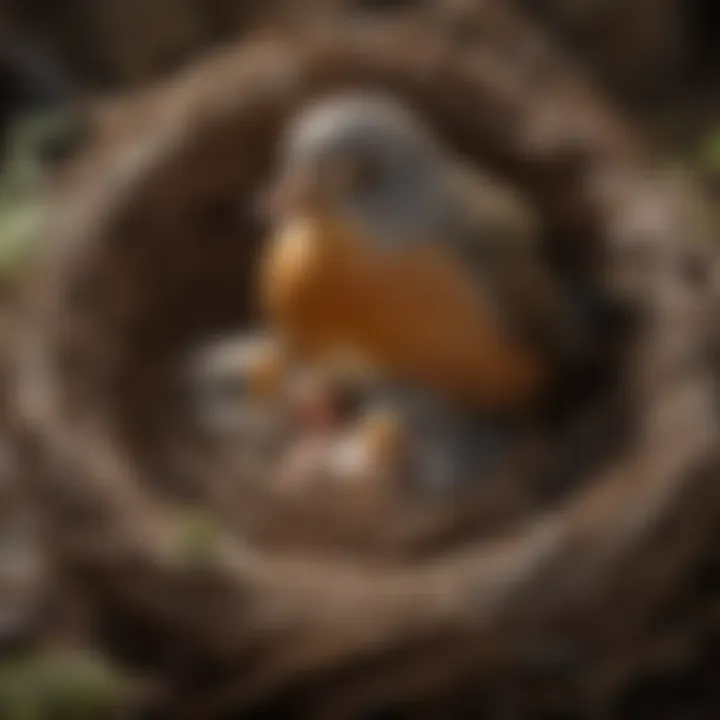The Reproductive Habits of Birds: An In-Depth Examination


Intro
The reproduction of birds is a subject that encompasses a variety of biological, environmental, and behavioral factors. Egg laying serves as a vital chapter in avian life. Understanding this process is essential for bird enthusiasts, pet owners, and professionals. It is crucial to delve into how different bird species vary in their reproductive habits, egg development, and care behaviors. Through this exploration, one can gain insightful knowledge regarding the intricate world of avian reproduction.
Care Tips
Maintaining the health of birds during their breeding seasons involves attentive care. Daily routines should be established to ensure the comfort and well-being of the birds.
Daily Care Routines
Regular feeding schedules are necessary. Provide fresh food daily, such as seeds, fruits, and vegetables. Maintain a consistent routine to minimize stress. Monitoring their behavior each day helps in identifying any changes that may indicate an issue.
Cage Setup and Maintenance
The cage should be spacious enough to allow movement, especially during the mating season. Including nesting materials is key. Ensure the cage is cleaned regularly. This reduces the risk of illness.
Hygiene and Cleaning Practices
Daily spot cleaning is vital. Removing droppings and uneaten food should become second nature. Weekly deep cleanings are also beneficial, where all surfaces and toys are scrubbed with bird-safe cleaners.
Seasonal Care Adjustments
In warmer months, hydration increases. Make sure water is always fresh and accessible. During colder months, consider warmth enhancements within the cage, particularly during laying periods. Adjusting care routines to fit seasonal changes promotes healthier laying.
Behavioral Insights
Comprehending bird behavior enhances the bond between the bird and owner. Birds exhibit numerous behaviors that signal their wellbeing or distress.
Understanding Bird Body Language
Birds communicate a lot through body language. Raised feathers can indicate excitement or fear, while fluffed feathers often suggest relaxation. Observing these cues aids in meeting their emotional needs.
Common Behavioral Issues and Solutions
Issues like feather plucking or excessive vocalization can occur. Understanding the cause, whether it's boredom or stress, is fundamental. Consulting an avian vet can provide valuable insight and solutions.
Positive Reinforcement Techniques
Training birds with positive reinforcement solidifies desirable behaviors. Using treats or praise helps in establishing a trusting relationship. For example, rewarding a bird for stepping onto your hand fosters confidence.
Social Interaction Needs
Social interactions are critical, particularly for flock-dwelling species. Allowing interaction with other birds can reduce loneliness and promote natural behavior. Consider group settings if space and conditions allow.
Nutrition Guides
Nutrition plays a significant role in the health and reproductive success of birds.
Essential Diet Components
Birds require a balanced diet rich in vitamins, minerals, and proteins. High-quality pellets can be a staple, supplemented with fresh fruits and vegetables. Each species may have specific needs.
Safe and Toxic Foods
Know which foods are safe and those that should be avoided. Avocado and chocolate are toxic and must never be offered. Researching safe options is essential for their health.
Supplements and Treats
During breeding, calcium is critical. Providing calcium sources or supplements can help strengthen eggs. Treats can include seeds or special mixes, but moderation is key to avoid obesity.
Feeding Strategies for Different Species
Different species have different needs. For example, parakeets thrive on seeds and fruits, while larger parrots benefit from a varied diet that includes vegetables and formulated pellets. Tailoring feeding strategies to the species ensures optimal health.
Wellness and Health
Monitoring the health of birds is crucial for preventing potential diseases and ensuring their longevity.
Routine Health Checkups
Regular checkups with an avian veterinarian should be instituted. This helps catch any potential health issues early and maintains overall wellness.
Identifying Symptoms of Illness
Watch for changes in behavior, appetite, or droppings. Signs of illness can vary. Early recognition can lead to prompt treatment, improving recovery chances.
Preventative Care and Vaccinations
Vaccinations and preventative medications are important. Regular veterinary advice can help determine necessary treatments based on the species and environment.
Mental and Emotional Well-being
Mental health is often overlooked. Engaging activities, social interaction, and environmental enrichment should be prioritized to keep birds both mentally and emotionally stimulated.
Enriching Activities
Providing stimulating activities is essential for the well-being of birds.
Toys and Playtime Ideas
Offer various toys to promote play. Rotating toys keeps interest high. Be mindful of toy materials; they should be safe and non-toxic.
Training and Tricks
Teaching birds tricks not only entertains them but also strengthens your bond. Start with simple commands and use positive reinforcement.


Outdoor Activities and Interaction
If conditions allow, supervised outdoor time can be refreshing for birds. Fresh air and sunlight are beneficial but must be carefully monitored to ensure safety.
DIY Projects for Mental Stimulation
Creating homemade toys or puzzles can enhance their environment. Simple projects, like hiding treats in boxes, challenge their minds and promote foraging instincts.
Understanding the reproductive habits of birds and providing adequate care are fundamental to their health and happiness.
Preface to Avian Reproduction
Understanding avian reproduction is essential for comprehending the life cycles of birds. The intricate processes involved in their reproduction command attention. Birds have developed a variety of strategies to reproduce successfully in diverse environments. The ability to adapt to changing ecological conditions plays a significant role in ensuring species survival. Factors like habitat availability, climate, and food sources significantly influence how reproduction occurs.
In avian reproduction, the act of egg laying stands out. It is not just a biological necessity but a critical stage in the life of birds. The health of the eggs and the parental care that follows directly affect the success of the offspring. Bird parents invest considerable effort to ensure that these eggs develop successfully, which is vital for the continuation of their species.
Understanding Bird Reproductive Strategies
Birds exhibit a range of reproductive strategies based on species-specific traits and environmental circumstances. Some birds are monogamous, choosing a single mate for a breeding season, or sometimes for life. In contrast, others may opt for polygamous arrangements. This choice affects not only mating behaviors but also parental investment.
Birds may also differ in timing. Many species time their breeding to align with optimal environmental conditions. For instance, some birds may nest in spring when food resources are abundant, while others may have more flexible strategies. This adaptability is vital for their survival.
Importance of Egg Laying in Bird Life Cycles
Egg laying is central to avian reproduction. It allows birds to produce multiple offspring simultaneously, increasing the chances of survival for at least some young. The egg itself serves as an incubator, providing necessary resources, including nourishment. Furthermore, the eggs’ protective shell is critical for safeguarding developing embryos from environmental hazards.
Effective egg laying and subsequent care can vary across species. Some birds may lay a few eggs and invest significant effort in incubation, while others produce many eggs with less intensive care. Understanding these differences provides insight into the diverse world of bird reproduction.
"Birds' reproductive strategies are intricate systems shaped by evolution, environment, and behavior."
In summary, an in-depth examination of avian reproduction reveals its significance in understanding ecosystems and wildlife conservation. The strategies that birds employ in their reproductive processes are key to their adaptation and survival.
Anatomy of Bird Reproductive Systems
Understanding the anatomy of bird reproductive systems is essential for examining their reproductive habits. The structure and functionality of these organs contribute significantly to the overall reproductive success of birds. In this section, we will explore the female and male reproductive systems, detailing their unique characteristics and their relevance to egg-laying behaviors.
Female Reproductive Organs
Structure of Ovaries
The structure of ovaries in birds differs from that of mammals. Birds typically possess a single functional ovary, often the left one. This adaptation allows for a streamlined reproductive process, reducing weight and enhancing flight capability. The ovarian structure also includes follicles which develop into eggs. Each follicle holds the oocyte, which matures and eventually becomes an egg during the ovulation process.
Key characteristics of bird ovaries include:
- Single Ovary: Most birds have only one functional ovary, facilitating efficient reproduction without the extra weight.
- Follicular Development: Each follicle’s growth is crucial for producing viable eggs.
This ovarian structure is beneficial for birds as it allows them to produce eggs while maintaining the physiological requirements for flight. However, a potential disadvantage is that any damage to the single ovary can lead to significant reproductive issues.
Oviduct Functionality
The oviduct plays a crucial role in the reproductive system of birds. After ovulation, the oocyte moves into the oviduct, where it undergoes several developmental stages before becoming an egg. The sections of the oviduct are specialized for specific functions, including fertilization, albumen (egg white) deposition, and shell formation.
A key feature of the oviduct includes:
- Segmented Structure: The oviduct has distinct segments, allowing for different processes to occur at various stages of egg development.
- Fertilization Site: It is the place where sperm meets the egg, ensuring successful reproduction.
This functionality is advantageous as it supports the complex process of egg formation and ensures the protection of the developing embryo. Nevertheless, any abnormalities in the oviduct can hinder the successful laying of healthy eggs.
Male Reproductive Anatomy
Testes Structure
The testes in birds are typically located within the body cavity, rather than external. This anatomical arrangement aids in temperature regulation, which is crucial for sperm production. Male birds generally possess paired testes that can enlarge during breeding seasons to increase sperm output.
A significant characteristic of avian testes includes:
- Internal Location: The internal position allows for better temperature control, vital for sperm viability.
- Size Variation: The testes can change size according to reproductive cycles, optimizing sperm production.
This structural feature is beneficial for male birds as it maximizes their reproductive potential. A downside may be that internal testes can make identification more challenging for ornithologists.
Sperm Production
Sperm production in birds occurs in the seminiferous tubules of the testes. It is a complex process influenced by hormonal changes and environmental factors. Male birds undergo seasonal fluctuations in sperm production, aligning with breeding seasons, which ensures higher chances of successful mating during the right times.
Key aspects of sperm production include:
- Hormonal Regulation: Testosterone and other hormones play significant roles in stimulating sperm production.
- Seasonal Variability: Sperm output increases during breeding seasons, enhancing reproductive success.
This adaptability in sperm production is an effective strategy for maximizing fertilization opportunities, though it also means male birds may experience periods of low sperm count outside breeding seasons.
In summary, understanding the anatomy of bird reproductive systems—both male and female—is essential for grasping the complexities of their reproductive habits. The adaptations found in these structures directly influence egg production and ultimately the conservation of bird species.
The Egg Laying Process
The process of egg laying is crucial in bird reproduction. It combines biological mechanisms with behavioral traits. Understanding this process can inform on numerous aspects of avian life, including species propagation and population dynamics. As a central theme of this article, this section delves into the stages of egg formation and the hormonal influences that facilitate egg production. Each of these elements contributes to successful reproduction, offering insights for bird owners and breeders alike.
Egg Formation Stages
From Ovum to Egg
The transition from ovum to egg is a complex process essential to avian reproduction. This stage starts when the female bird's ovary produces ova, which are the immature eggs. The key characteristic of this stage lies in how the ovum undergoes maturation within the female's reproductive system. This stage is significant because it lays the foundation for subsequent egg development.
A unique feature of this process involves the contribution of the oviduct. As the ovum moves through it, various layers are added. This includes the albumen, membranes, and finally, the eggshell. This process can take several hours to complete. The advantages include the ability to produce strong, viable eggs, ready for fertilization. However, challenges arise, such as potential hormonal imbalances that could affect development.
Shell Formation and Composition


Once the egg is formed, the next stage focuses on the shell's development. It is important for protection and is primarily composed of calcium carbonate. The characteristic of this stage is that shell formation occurs while the egg moves through the last part of the oviduct. Notably, the composition of the eggshell is paramount as it impacts the embryo's survival during incubation.
The unique feature here is the strength and porosity of the shell. A well-formed shell provides crucial protection against external factors. Advantages include ensuring that the developing embryo has an appropriate environment. However, a disadvantage can occur if the shell is too thick or too thin, which affects the chick's ability to hatch effectively. This stage highlights the intricate balance necessary for successful egg-laying in birds.
Hormonal Influences on Egg Production
Role of Estrogen and Progesterone
Hormones play a fascinating role in avian reproduction. Estrogen and progesterone are particularly important in regulating the reproductive cycle. Estrogen helps stimulate the development of the follicles in the ovaries, leading to ovum maturation. Progesterone, on the other hand, prepares the reproductive tract for the eventual egg-laying process. This is a beneficial aspect of the hormonal influence as it ensures proper timing in the reproductive cycle.
One unique feature of these hormones is their interaction with environmental factors, which can affect their levels. Advantages include enhanced ability to adapt reproductive timing based on environmental cues, such as seasonal changes. This means that optimal reproductive conditions can enhance the chances of egg viability. Disadvantages may include hormonal disruptions due to stress or environmental changes that could impair reproductive success.
Environmental Triggers
Environmental triggers significantly influence egg production in birds. These triggers include factors like daylight length, temperature, and availability of resources. The relationship between these factors and egg-laying patterns is crucial, especially for species that rely on specific conditions for breeding.
A key characteristic of environmental triggers is their ability to prompt hormonal changes that stimulate egg production. They are essential for adapting to changing climates and seasons. The unique feature of this influence allows for synchronization of breeding with optimal resource availability. Benefits include improved chances for the survival of the offspring. However, adverse environmental changes can result in disrupted breeding cycles, impacting population stability.
Key Consideration: Understanding the egg-laying process and its underlying factors can vastly improve breeding practices and the care of pet birds.
Nesting Behaviors Across Species
Nesting behaviors are pivotal to understanding how birds reproduce. This section highlights the various techniques birds employ to build nests and care for their eggs. The process of nesting provides essential insights into reproductive success and species adaptation.
Nest Building Techniques
Variations in Nest Types
Birds have developed an array of nesting types, showcasing the diversity within avian species. This aspect emphasizes the adaptive strategies that birds employ to create secure environments for their eggs. A key characteristic of these nest types is their material composition, which varies significantly among species. For instance, some birds prefer cup-shaped nests, while others build elaborate, woven structures.
The variation in nest types is beneficial as it reflects the specific needs of each species, related to predation risks and environmental conditions. A unique feature of some nests, such as those of the weaver bird, is their intricacy and strength, providing high protection against threats. However, constructing such nests requires time and resources, which can be a disadvantage in rapidly changing environments.
Material Selection
Material selection is crucial in the nest-building process. Birds choose materials based on availability in their habitats and their specific protective needs. Grass, twigs, feathers, and even mud are common choices among various species. The key characteristic of material selection is its impact on the nest's insulation and structural integrity.
This selection process is popular in this discussion as it illustrates how birds utilize their environment. A unique aspect of material selection is the incorporation of human-made items, like plastic, which can be advantageous due to durability. However, it also introduces complications, as such materials can be harmful to the overall well-being of the nest's inhabitants.
Parental Roles in Egg Care
Incubation Duties
Incubation duties are a significant aspect of avian parental behavior. The act of incubating eggs involves both male and female birds, depending on the species. A defining characteristic of incubation is the warming process that ensures embryonic development occurs properly. This aspect is central to the survival of the young birds after hatching, proving its importance for the avian population.
This shared responsibility is beneficial as it allows adults to balance their time between feeding and protecting the nest. However, it can lead to challenges if one parent fails to participate, potentially risking the viability of the eggs.
Caring for Hatchlings
Caring for hatchlings represents another critical role for parent birds. After eggs hatch, the focus shifts to feeding and protecting the young. A key aspect of this care is the transfer of knowledge and skills essential for survival. The unique feature of this stage is the parents’ ability to choose appropriate food sources and teach fledglings how to forage.
This parental involvement is vital as it increases the chances of the young birds reaching maturity. However, strict resources may limit their capacity to provide adequate nourishment, affecting the overall survival rates of hatchlings.
Egg Incubation and Development
Egg incubation and development are vital processes in avian reproduction, serving as a bridge between egg laying and the emergence of hatchlings. This stage is crucial for the successful growth of embryos and ultimately determines the survival of the species. Various factors impact incubation, including temperature, humidity, and the specific behaviors adopted by parent birds. Understanding these elements gives insight into how birds adapt their reproductive strategies to their environments.
Temperature and Humidity Requirements
Proper temperature and humidity levels are essential for egg incubation. Most bird species require a specific temperature range, generally between 37 to 39 degrees Celsius (98.6 to 102.2 degrees Fahrenheit), to facilitate embryonic development. This consistency ensures that metabolic processes necessary for growth occur effectively.
Humidity also plays a crucial role, especially during the later stages of incubation. High humidity can cause the eggs to absorb excess moisture, which may impede the embryo's ability to develop properly. Conversely, too little humidity can lead to dehydration. The demands for humidity can vary widely. For example, species like the Emperor Penguin incubate their eggs in relatively low humidity, while tropical birds might prefer higher levels.
Duration of Incubation Periods
The duration of incubation varies significantly across species. Most birds incubate their eggs for 10 to 80 days, influenced largely by the size and type of the bird, as well as environmental factors. During this period, both male and female parents may share the incubation duties, although this varies by species.
Species-Specific Variations
The length of incubation is quite diverse across species. For instance, smaller songbirds might incubate their eggs for about 12 to 15 days, while larger birds like the Bald Eagle can take anywhere from 35 to 40 days. This variety is beneficial as it illustrates how different birds have evolved to adapt their reproductive cycles based on environmental pressures and ecological niches.
A unique feature of this variation is that birds have also developed different mechanisms for thermoregulation. Some birds, like certain species of ducks, can adjust the temperature of their brood by shuffling the eggs. This variability allows them to optimize the conditions necessary for successful hatching, thereby enhancing their chances of species survival.
Impact of Environmental Conditions
Environmental conditions have a profound effect on incubation duration. Factors such as temperature fluctuations, food availability, and even predation pressures can influence how long a bird goes through the incubation process. If environmental conditions are not favorable, some species may delay incubation to ensure that the conditions are optimal for their eggs.
For instance, if a cold snap occurs, birds may pause incuation until temperatures rise. This adaptability demonstrates a key characteristic of avian species, ensuring the survival of their offspring even if it means delaying the hatching process. While this behavior ensures that the chicks have a better chance of thriving, it also introduces risks related to the timing of food availability and predator activity.
"Understanding these incubation strategies not only aids enthusiast and bird breeders but also contributes to overall avian conservation efforts."
Variations Among Avian Species
Understanding the variations among avian species in relation to their reproductive habits is vital in studying birds. Each species has adapted its reproductive strategies to fit its unique ecological niche. This adaptability affects not only their egg-laying behaviors, but also the success of their offspring in various environments.
Oviparous vs. Ovoviviparous Species
Birds are predominantly oviparous, which means they lay eggs that develop outside their bodies. However, there are exceptions within the broader animal kingdom. In avian study, consider the basic difference between oviparous and ovoviviparous species. Oviparous species deposit eggs in a nest or other safe locations to incubate until hatching. This is seen in species such as the American Robin and the Bald Eagle.
In contrast, while birds do not exhibit true ovoviviparity, some species might display behaviors that incorporate aspects that parallel this phenomenon. Ovoviviparous species retain eggs inside their bodies until they are ready to hatch. In comparison, reptiles, like some species of snakes, can exhibit true ovoviviparity. This highlights the evolutionary commitment birds have toward external egg-laying and protecting their young through dedicated nesting behaviors.
"The reproductive methods of birds reflect centuries of evolution and adaptation to the diverse environments they thrive in."
Influence of Habitat on Egg-Laying Patterns
The habitat has a significant influence on a bird's egg-laying patterns. Different environments present unique challenges and advantages that shape reproductive behaviors. For instance, waterfowl like ducks lay eggs in dense grasses or reeds, providing camouflage from predation. On the other hand, birds living in forests, like the Great Horned Owl, often nest in tree ledges or cavities to offer safety from threats.


Consider some specific factors affecting egg-laying patterns:
- Seasonal Timing: Many birds time their egg-laying to coincide with favorable environmental conditions, like abundant food and optimal weather. Species like the Eurasian Blue Tit lay their eggs in spring to take advantage of increased insect availability for feeding their chicks.
- Nest Location: Different habitats create diverse nesting opportunities. Ground-nesting birds like the Killdeer may expose their eggs to higher risks from predators. In contrast, cavity-nesting birds find a safer option, as seen in woodpecker species.
By reviewing these behaviors, one can appreciate how critical the relationship between habitat and reproductive strategy is to avian survival. The understanding of such adaptations informs bird care practices, ensuring that enthusiasts and breeders can create conducive environments for their birds.
The Role of Environmental Factors
Understanding the role of environmental factors is crucial when examining the reproductive habits of birds. These influences encompass climate, seasonality, and resource availability, which can significantly affect when and how birds lay their eggs. In many cases, these factors determine the timing of reproductive cycles, ensuring that birds can maximize their chances of survival and the success of their offspring.
Climate and Seasonality in Egg Laying
Climate plays a pivotal role in the reproductive behavior of various bird species. The variation in temperatures can influence the breeding season. Many birds tend to align their egg-laying with warmer months when food resources are abundant. For instance, in temperate regions, you often see increased laying in spring. This timing ensures that hatchlings have ample food when they emerge, thus enhancing their survival rates. Additionally, migratory birds also consider climate cues. They only return to their breeding grounds after environmental conditions are favorable.
Availability of Resources
The availability of resources is another critical consideration in the reproductive habits of birds. Factors such as food sources and nesting materials directly impact egg-laying success. Birds need to ensure that there is enough food to sustain them and their young after hatching. In areas where resource availability fluctuates, birds may adapt their laying strategies to accommodate these changes.
Food and Nesting Materials
Food sources are vital for breeding success. A rich availability of insects, seeds, or fruits can lead to increased reproductive success. Birds often choose nesting locations based on nearby food resources. This ensures that parents can easily access enough nutrition to support both themselves and their hatchlings.
Nest construction also depends heavily on material availability. Different birds utilize various natural items, such as twigs, leaves, and feathers, to build their nests. This choice not only provides structural integrity but also insulation and camouflage from predators. The location and accessibility of these materials add an additional layer to how and where birds lay eggs. Overall, the characteristics of food and nesting materials and their availability are key factors in the reproductive strategies of birds.
"Environmental conditions shape the timing and location of egg-laying in birds, ensuring that their young have the best possible start in life."
In summary, environmental factors are essential to the overall topic of bird egg-laying. Understanding these influences offers valuable insights into avian reproductive strategies and the challenges they face. By considering these elements, pet bird owners, aspiring bird parents, and bird breeders can gain a deeper appreciation for the complexities of avian reproduction.
Challenges in Egg Laying and Care
The act of egg laying is pivotal in the reproductive cycle of birds. However, it is fraught with various challenges that impact both the eggs and the fledgling birds. Understanding these challenges is essential for anyone interested in avian biology and the well-being of bird species. This section explores different risks that birds encounter during the egg laying and care phases, particularly focusing on predation risks and human impacts on natural nesting.
Predation Risks During the Egg Stage
During the egg stage, one of the most significant threats that birds face is predation. Many species lay eggs in locations that are vulnerable to predators. Ground-nesting birds, for example, are particularly at risk. Their eggs can be easily spotted and eaten by various animals, such as raccoons, snakes, and even other birds. The loss of eggs to predators can be devastating for bird populations and can affect the species' overall reproductive success.
Birds have developed various strategies to mitigate these risks. They often lay a large number of eggs to increase the likelihood that at least some will survive. Some birds employ cryptic coloring of their eggs to blend into their environment, making it harder for predators to locate them. Additionally, some species will exhibit distraction behaviors, feigning injury to lure predators away from their nests. Understanding these predation risks highlights the delicate balance of survival strategies birds must navigate in nature.
Human Impact on Natural Nesting
Habitat Loss
Habitat loss is a growing concern that greatly affects bird populations worldwide. Urbanization, agriculture, and deforestation are primary contributors to this loss. Birds rely on specific environments for nesting, and when these habitats are altered or destroyed, it can lead to decreased reproductive success.
The key characteristic of habitat loss is the fragmentation of nesting areas. This fragmentation forces birds to adapt to new, often suboptimal environments. As a consequence, many species may struggle to lay eggs in safe, suitable locations. In some cases, this leads to a decline in bird populations and threatens the biodiversity that relies on these species.
Pollution Effects
Pollution also plays a crucial role in the challenges birds face during the reproductive phase. Chemicals and waste that infiltrate natural habitats can severely impact birds and their eggs. For example, pesticides used in agriculture often end up in the organic supply chains that birds depend on. Consuming contaminated food can impair breeding success and even lead to mortality.
Another significant aspect of pollution is the physical changes it brings to habitats. Plastic waste and other pollutants can alter nesting conditions, making it more challenging for birds to find safe places for their eggs. The unique feature of pollution effects is that they can be subtle yet damaging over time, resulting in reduced fertility rates and higher embryo mortality.
"Understanding the challenges in egg laying and care is essential for effective conservation efforts to protect bird species in changing environments."
The examination of these factors provides insight into why it is vital to consider the broader ecological implications of habitat alteration and pollution. In turn, it underscores the need for proactive measures to ensure the health of avian populations.
Conservation Implications
The conservation of bird populations is vital for maintaining ecological balance. Birds play critical roles in ecosystems, such as pollination, seed dispersal, and pest control. Their reproductive habits directly influence their population dynamics and overall health. With many species facing threats, understanding the implications of conservation becomes essential in promoting sustainability.
Protecting Nesting Habitats
Nesting habitats provide the foundation for avian reproduction. Protecting these areas is crucial for species survival. Habitat destruction from urban development, agriculture, and climate change poses significant risks.
Effective conservation strategies include:
- Implementing protected areas: Establishing reserves allows birds to nest without human interference.
- Restoring degraded habitats: Restoration projects can revitalize natural areas, benefiting nesting birds.
- Creating awareness campaigns: Educating the public about the importance of nesting sites can promote community support for conservation efforts.
If bird enthusiasts and conservationists collaborate, it can lead to successful initiatives that conserve these critical habitats.
Restoration Efforts for Bird Populations
Restoration of bird populations requires comprehensive strategies. These efforts can address declining numbers and enhance biodiversity. Important aspects include:
- Monitoring bird populations: Data collection helps identify species at risk and evaluates the effectiveness of restoration initiatives.
- Reintroducing native species: Bringing back birds that have disappeared from certain areas can restore ecological balance.
- Promoting sustainable practices: Encouraging environmentally friendly farming and land use can reduce habitat loss and support avian life.
Conservation efforts can lead to healthier bird populations, benefiting ecosystems in the long term. Investing in these restoration initiatives is vital for future generations of birds and their habitats.
"Protecting and restoring habitats is crucial for bird populations and can have lasting impacts on biodiversity."
By focusing on these conservation implications, pet bird owners, aspiring bird parents, and bird breeders can contribute meaningfully to the effort of sustaining avian life.
The End
The conclusion of this article serves as a crucial component to summarize the essential findings and insights regarding avian reproduction, particularly egg laying. Understanding the reproductive habits of birds is not only interesting but also vital for various stakeholders, including pet bird owners, aspiring bird parents, and bird breeders. It emphasizes the complexity behind the seemingly simple act of laying eggs and the influence of various biological and environmental factors.
By reviewing the topics covered in this article, readers can appreciate the intricate relationship between a bird’s reproductive anatomy, nesting behaviors, and egg care. Recognizing the challenges and considerations faced during the egg laying process can help bird enthusiasts provide better care for their avian companions. Furthermore, it raises awareness about conservation implications, highlighting the need to protect nesting habitats crucial for the survival of bird populations.
Understanding these factors contributes to better bird management practices. It also supports the advancement of knowledge in avian research, encouraging further exploration of this fascinating subject.
Summary of Key Points
- Complex Biology: Birds show diverse reproductive strategies influenced by their anatomy and behavior.
- Nesting Importance: Nest building and parental care are critical for the survival of hatchlings.
- Environmental Considerations: Climate and available resources significantly impact egg-laying habits.
- Challenges Faced: Both natural predators and human impact pose risks to eggs and nesting sites.
Future Directions in Avian Research
There is a vast scope for future studies to enhance our understanding of avian reproduction. Research could focus on:
- Genetic Influence: Investigating how genetics affect reproductive behaviors and egg viability across different species.
- Climate Impact: Analyzing how changing climates influence nesting patterns and success rates in various environments.
- Conservation Strategies: Developing effective strategies that will safeguard nesting habitats from urban development and pollution.
- Behavioral Studies: Exploring specific parental roles during the incubation and care stages to identify species-specific variations.
Continuing to study these areas will deepen our knowledge of birds, facilitating better care practices and conservation efforts necessary to protect these species.















